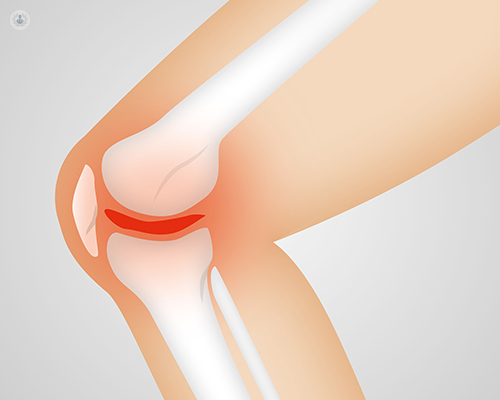Total or partial knee replacement: which is the right one for me?
Written by:When a patient needs a knee replacement due to arthritis, there are two standard options: total knee replacement and partial knee replacement. These procedures both have their own advantages and disadvantages, as outlined by leading orthopaedic surgeon Mr Christopher Arthur Bailey in his latest article below.

What should I choose: a partial or a total knee replacement?
To answer this question, it is best to establish what is meant by both of these terms.
A total knee replacement is when all surfaces of the knee are removed, and a new metal cap is placed at the end of the femur, a new metal tray on top of the tibia, a spacer between the two, and a new surface on the back of the kneecap. This procedure is done to address arthritis in the three main compartments of the knee: the inner side, the outer side and the front.
Some patients have arthritis in just one of these parts of the knee, the most common being the inner side. It stands to reason that if just the affected part of the knee can be removed while retaining all of the intact surfaces completely pristine, then the patient will regain function more quickly. In these situations, a partial knee replacement should be considered.
What factors are taken into consideration when making a decision on which one is the most suitable?
Suitability is initially determined by the pattern of arthritis. If the arthritis is limited to just one side of the knee, then a partial knee replacement may be considered.
Another factor we need to look at is the range of movement. It is difficult after a partial knee replacement to increase the patient’s range of movement, particularly by straightening the knee out. If the patient is completely unable to straighten the knee or has lost flexion, a total knee replacement may be better.
Similarly, if there is a lot of bowing of the leg, or the knee comes out to the side when looked at from the front, this may be better addressed by a total knee replacement.
The patient’s activity level must also be taken into account. If someone is very active, in particular younger patients who enjoy exercise, walking or sports such as golf, then a patient may do better with a partial knee replacement instead of a total knee replacement.

Are both partial and total knee replacement operations performed similarly?
They are performed in a similar way, so the anaesthetic used is usually the same. Most procedures are performed with spinal anaesthetic, so the patient will be numb from the waist down, and the patient can be asleep for the operation.
The incision is made over the front of the knee. For a partial knee replacement, the incision tends to be a little smaller. The approach is slightly less invasive as well, which may help with recovery time. For a total knee replacement, we need to expose the entire knee, but for a partial knee replacement, we only need to expose the area of the knee that needs addressing. The suturing also tends to be less invasive with a partial knee replacement. Following the procedure, the knee is often treated with glue, steri strips and a dressing.
Which has the best prognosis?
Both are very successful operations. Patients who are suffering from severe pain due to bone-on-bone arthritis tend to see their symptoms improve significantly following their surgery. Most people will be much more comfortable and will be able to walk further following the procedure.
There can still be some limitations. Not many people can run following the surgery, and strenuous activities like skiing, hiking or climbing can be difficult after knee replacement surgery. What we tend to find is that active patients who want to return to a higher level of activity, such as longer walks, or playing some recreational tennis or golf, may function better with a partial knee replacement rather than a total knee replacement.

When it comes to recovery time, what are the main similarities and differences?
These are quite big operations, and initially, patients may experience discomfort following the surgery. However, this improves on a daily basis, and within a few weeks, we see a big improvement.
After partial knee replacement, people tend to return to normal activities such as short walks 3 or 4 weeks after the surgery. Following total knee replacement, this can take longer and it is normally about 4 to 6 weeks before people are out and about.
Mr Christopher Arthur Bailey is a leading orthopaedic surgeon based in Winchester and Southampton. If you are considering a knee replacement or any other orthopaedic procedure, you can book a consultation with Mr Bailey via his Top Doctors profile today.


